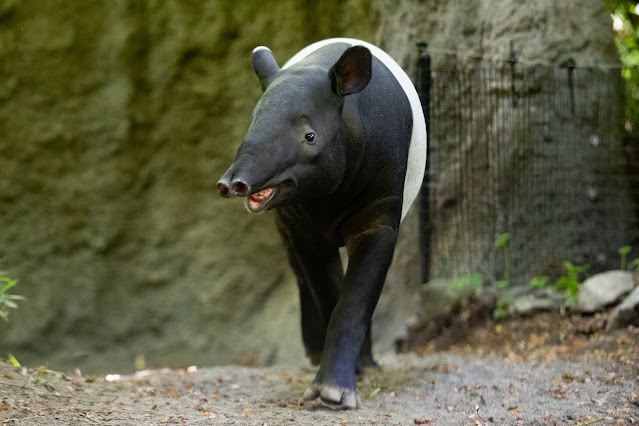Posted by Gigi Allianic, Communications
The new tapir moved from Minnesota Zoo under a breeding recommendation by the Malayan Tapir Species Survival Plan. Species Survival Plans are cooperative breeding programs across accredited zoos to help ensure healthy, genetically diverse populations of select species or subspecies.
Tapirs are among the most primitive large mammals in the world, changing little in appearance for millions of years. These prehistoric-looking animals are long and similar to the weight of a light horse and look like a massive pig with a long snout. Because they have an odd number of toes (four toes on each front foot, three on each back foot), their closest relatives are horses and rhinos.
Tapirs definitely have distinct personalities, explained Pat Owen, an animal care manager at Woodland Park Zoo. “Tuah is curious about his new digs and is enjoying exploring the outdoors. He has acclimated well, we continue to learn what motivates him. We’re excited he’s here and we look forward to growing the tapir family in the near future.”
Malayan tapirs are the largest of the four species of tapirs and are fairly rare in zoos in North America with only 37 Malayan tapirs currently living in North American zoos.
Zoo-goers can get to know the tapirs in the Trail of Vines. The zoo’s exhibits and animal care teams recently made upgrades to the tapir habitat including a new training panel to allow various access points for health and husbandry interactions; the replacement of new heating coils to keep the tapirs warm and toasty during the winter; a reconstructed viewpoint to allow visitors to go nose to snout with the tapirs; newly repainted bedrooms; and improvements to the overall grade in the yard to reduce slip hazards. Trail of Vines is also home to orangutans, siamangs, François’ langurs and Visayan warty pigs.
Tuah and Binti will live separately in the habitat until they are introduced for breeding in the future. Visitors may need to exercise a little patience if they don’t spot both tapirs; as they are adjusting to their new surroundings, they may not always be viewable, explained Owen.
A little about tapirs
 |
| Welcome, Tuah! We're already smitten with you! Photo: Jeremy Dwyer-Lindgren/Woodland Park Zoo |
Last month Woodland Park Zoo heralded the arrival of a new female Malayan tapir, Binti. Now, her future companion, a male named Tuah, has completed the cross-country trek from Minnesota and is settling into his new digs at the zoo. Tuah, whose name means “good fortune or luck” in Malay, will turn 5 on August 8.
The new tapir moved from Minnesota Zoo under a breeding recommendation by the Malayan Tapir Species Survival Plan. Species Survival Plans are cooperative breeding programs across accredited zoos to help ensure healthy, genetically diverse populations of select species or subspecies.
Tapirs are among the most primitive large mammals in the world, changing little in appearance for millions of years. These prehistoric-looking animals are long and similar to the weight of a light horse and look like a massive pig with a long snout. Because they have an odd number of toes (four toes on each front foot, three on each back foot), their closest relatives are horses and rhinos.
 |
| This handsome chap, who comes to Woodland Park Zoo from Minnesota Zoo, will turn 5 in August. Photo: Jeremy Dwyer-Lindgren/Woodland Park Zoo |
Tapirs definitely have distinct personalities, explained Pat Owen, an animal care manager at Woodland Park Zoo. “Tuah is curious about his new digs and is enjoying exploring the outdoors. He has acclimated well, we continue to learn what motivates him. We’re excited he’s here and we look forward to growing the tapir family in the near future.”
Malayan tapirs are the largest of the four species of tapirs and are fairly rare in zoos in North America with only 37 Malayan tapirs currently living in North American zoos.
Zoo-goers can get to know the tapirs in the Trail of Vines. The zoo’s exhibits and animal care teams recently made upgrades to the tapir habitat including a new training panel to allow various access points for health and husbandry interactions; the replacement of new heating coils to keep the tapirs warm and toasty during the winter; a reconstructed viewpoint to allow visitors to go nose to snout with the tapirs; newly repainted bedrooms; and improvements to the overall grade in the yard to reduce slip hazards. Trail of Vines is also home to orangutans, siamangs, François’ langurs and Visayan warty pigs.
 |
| Tuah will soon be introduced to 2-year-old female Malayan tapir Binti (seen here) who made her debut in the newly upgraded tapir habitat last month. Photo: Jeremy Dwyer-Lindgren/Woodland Park Zoo |
Tuah and Binti will live separately in the habitat until they are introduced for breeding in the future. Visitors may need to exercise a little patience if they don’t spot both tapirs; as they are adjusting to their new surroundings, they may not always be viewable, explained Owen.
A little about tapirs
- This prehistoric-looking animal looks like a massive pig with a long snout. Tapirs use their short, prehensile nose to pluck leaves and fruit.
- Tapirs are excellent, fast swimmers and often use their trunk-like snout like a snorkel!
- Tapirs are highly endangered in the wild. The Malayan tapir ranges in Thailand, Peninsular Malaysia, Sumatra and Myanmar. The other three species are found in Central and South America. Fewer than 2,500 Malayan tapirs remain in the wild.
- Woodland Park Zoo partners with conservation projects in Peninsular Malaysia and Sumatra, where tapirs are found. One of the greatest threats to tapirs is loss of habitat. By protecting land for tigers, orangutans and hornbills, the zoo is also protecting land for tapirs. Protect tapirs and the forests they live in by making informed purchasing decisions and buying products with certified sustainable palm oil and choosing Forest Stewardship Council (FSC) certified paper and wood products
Comments
Post a Comment